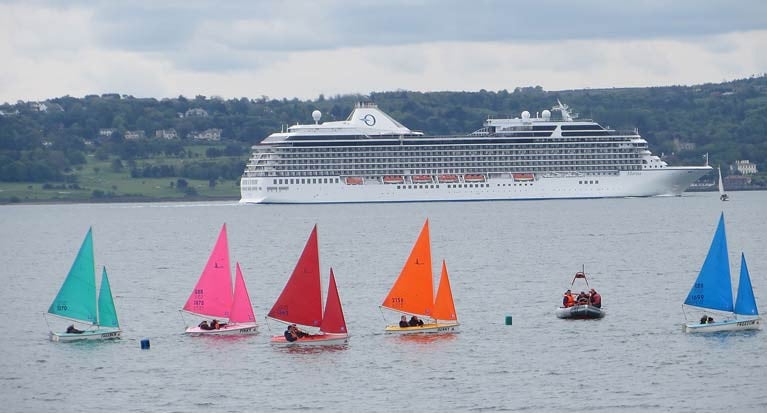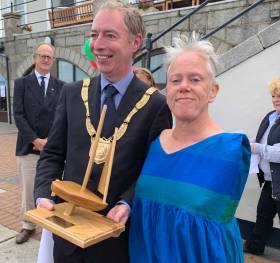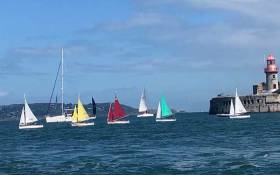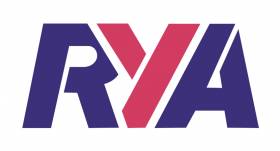Displaying items by tag: Sailability
Kinsale Yacht Club's commitment to promoting inclusiveness in sailing has been recognised with nominations for the annual Cork's Sports Partnership awards.
Sailability Kinsale and KYC promoter Donal Hickey have both been nominated as finalists in the 'active community' section of Wednesday's awards.
 Sailability Kinsale and KYC promoter Donal Hickey have both been nominated as finalists in the 'active community' section of Wednesday's awards
Sailability Kinsale and KYC promoter Donal Hickey have both been nominated as finalists in the 'active community' section of Wednesday's awards
As regular Afloat readers know, in June the West Cork club welcomed the Minister of State at the Department of Children, Equality and Disability, Anne Rabbitte, to launch its new Sailability fleet of access dinghies and a new Whaly Safety boat.
Sailability Ireland is a ‘not-for-profit’ organisation to encourage wider participation and has provided the resources to purchase specially adapted boats.
 Minister of State at the Department of Children, Equality and Disability, Anne Rabbitte, with Kinsale Yacht Club's Sailability promoter Donal Hickey at the launch of the new fleet in June Photo: Bob Bateman
Minister of State at the Department of Children, Equality and Disability, Anne Rabbitte, with Kinsale Yacht Club's Sailability promoter Donal Hickey at the launch of the new fleet in June Photo: Bob Bateman
Listen to Tom Macsweeney's 2019 podcast here and see photos from June's Sailability launch at KYC by Bob Bateman here
Bob Harper, a dedicated sailing volunteer for almost 20 years, is among those named in the King’s Birthday Honours list on Saturday (17 June).
Bob is awarded an MBE for services to sailing for people with disabilities in Northern Ireland and is one of more than 100 people on the list — the first named by King Charles III.
The Carrickfergus man took up the role of RYA Northern Ireland sailability coordinator 2003 and over 18 years worked with clubs and centres all over the region. He stepped down from the role at the end of 2021, as previously reported on Afloat.ie.
Under his tenure, three dedicated sailability clubs were set up along with five accredited centres. They continue to bring the joy of sailing to disabled and disadvantaged people right across Northern Ireland.
Bob has always been an advocate for disabled sailing, helping to create and maximise opportunities for sailors, as well as supporting many initiatives and activities.
He helped to establish Belfast Lough Sailability, which has given hundreds of adults and children with any form of disability the opportunity to take up the sport and learn the skill of sailing.
Bob is also a keen author and illustrator and has written about his adventures sailing around the world with wife, Christine.
Greg Yarnall, chief executive officer of RYANI congratulated Bob, saying: “I am delighted that Bob has been recognised with an MBE for all of the hard work he has done for our sport. His enthusiasm is a shining example of all that is good about sailing and our dedicated volunteers.
“Over the years Bob has played a huge role in helping the sailabilty community grow from strength to strength in Northern Ireland. As a result of his hard work, hundreds of people have been able to enjoy sailing, regardless of their ability or their background.”
Commenting on his recognition, Bob says: “It’s a bit surreal, I’m going to have to buy a suit! I have lots of people calling and the WhatsApps are flying. It’s just great to be able to look back on all of the friends we have made and I am delighted that the organisation for disabled sailing has been recognised.
“My initial thoughts when I found out about it were of the many, many volunteers who supported me. This is the recognition of the work that countless volunteers have done over the years – without them, none of it could have happened. I was just the figure head for the whole thing.
“I didn’t start sailing until I was in late 30s and I was so enthusiastic I just wanted other people to enjoy it and I am delighted that I have had the opportunity to do all of this.”
RYA Northern Ireland Appoints New Sailability Coordinator
Ken Curry, secretary of Foyle Sailability, has been appointed as RYA Northern Ireland’s sailability coordinator for the reguon.
Curry took up the post this month and says he is looking forward to helping people with disabilities to get out on the water and take part in sailing and water-based activities.
A later convert to sailing in his thirties, Curry is a member of Lough Swilly Yacht Club in Donegal. Also a keen cruiser, he circumnavigated Ireland on Kind of Blue, Garry Crothers’ Ovni, as part of an effort to raise awareness of sailability throughout Ireland.
Curry has taken part in many challenges over the years, some of which he says have been “life-changing”. He was asked to help out when Bob Harper (former sailability coordinator) brought a group of volunteers from Belfast Lough Sailability to Derry for the first ever sailability event on the River Foyle.
Many of the volunteers stayed with Foyle Sailability, Curry eventually became secretary and the club went from strength to strength.
Commenting on his new post, Curry said: “As someone who has been involved with sailability for quite a few years now, I enjoy helping when I can and I’m a firm believer in giving those with disabilities the opportunity to get on the water.
“I understand that for a lot of our sailors, just being on the water is stimulation enough, but there are also others who have the skills, drive and abilities to become very competent and competitive sailors, too.
“I am delighted to have been appointed sailability coordinator and I’m proud to continue my support of RYA Northern Ireland as I believe it to be one of the most respected organisations locally and throughout the world.
“I am looking forward to helping to give more disabled people — both young and old — the opportunity to enjoy our great sport.”
Congratulating Curry on his new role, RYA Northern Ireland’s outgoing chief operating officer Richard Honeyford said: “Ken has been an excellent advocate and ambassador for sailability in Northern Ireland for many years.
“His enthusiasm for our sport is infectious and I am looking forward to seeing him continue on his journey to making our sport even more accessible to people of all abilities right across Northern Ireland.”
Foyle Sailability Gets a Permanent Base
The River Foyle flows into Lough Foyle in the North West of Northern Ireland through the city of Derry and in that area there are already established the Marina, Foyle commercial Port, Lough Foyle Yacht Club and Foyle Search and Rescue. Now Foyle Sailability, who up until this season had no permanent base, have seen work start on their first home at Prehen less than two miles upriver from the City.
The Derry and Strabane District Council has given the club a compound and a container, and a new pontoon is being built there. As there are only certain times that work on the riverbank can be undertaken because of wildlife, construction has just begun with a completion date sometime in the Spring.
The club has a core of 30 regulars, sailors and volunteers, but pre Covid the membership was much larger. However, it is hoped that they will be able to hold events this year, with the situation becoming more normal. Having space to store the fleet of four Hanse dinghies, a Hawk and two safety boats is a bonus.
 Prehen, the site of the new pontoon
Prehen, the site of the new pontoon
Lough Foyle Yacht Club member and Chairman of Foyle Sailability Garry Crothers, the one-armed sailor who sailed single-handed in 2020 from the Caribbean was Afloat Sailor of the Month in June that year and last year the Ocean Cruising Club (OCC) awarded Garry its 2020 Seamanship Award. And Secretary Ken Curry was recently honoured by HRH The Princess Royal at a Ceremony in London with an Outstanding Contribution award.
 Ken Curry (left) was given an Outstanding Contribution award by HRH The Princess Royal recently
Ken Curry (left) was given an Outstanding Contribution award by HRH The Princess Royal recently
Garry and Ken are delighted that Foyle Sailability will have a base to work from at long last. “Foyle Sailability is super excited to see the work started on a new pontoon at Prehen. The 66-metre pontoon will have services, disabled access and a hoist to enable wheelchair users access to the river. Derry City and Strabane Council will provide a compound and container for storage. This will be the first time in 10 years that Foyle Sailability has been going that they will have somewhere to call home. The work is to be completed by the early Springtime, so after two particularly bad years, we can look forward to getting our disabled sailors out on the water on a regular basis”.
 Garry Crothers
Garry Crothers
Bob Harper Steps Down as RYANI Sailability Coordinator
Carrickfergus sailor Bob Harper has stepped down from his role of RYA Northern Ireland sailability coordinator.
Harper took up the role in 2003 and over the last 18 years he has worked with clubs and centres across Northern Ireland as an advocate for disabled sailing, helping to create and maximise opportunities for sailors, as well as supporting many initiatives and activities.
He helped to establish Belfast Lough Sailability, which has given hundreds of adults and children with any form of disability the opportunity to take up the sport and learn the skill of sailing.
Harper’s dedication was recognised with a prestigious national award in 2010, the RYA Francis Elkin Award.
He is also a keen author and illustrator and has written about his adventures sailing around the world with his wife, Christine.
RYANI’s chief operating officer Richard Honeyford commented: “During his tenure, Bob became well recognised and respected. His enthusiasm and dedication have been a huge asset to our sport and Bob has played a huge role in helping the sailability community grow from strength to strength.
“We now have three dedicated sailability clubs in Northern Ireland and five accredited centres and this is a testament to Bob’s hard work.”
Honeyford added: “Bob led sailability with true commitment and was always approachable and innovative, exploring new opportunities to support sailing.
“On behalf of RYA Northern Ireland, I would like to thank him for the very positive impact he has made on our sport. He will be sorely missed by us all.”
Belfast Lough Sailability Host Regatta at Carrickfergus
Belfast Lough Sailability held a very successful regatta out of Carrickfergus Marina last Saturday (7th August) and welcomed visitors from Lough Foyle in the North West and Lough Erne in County Fermanagh, making eight boats in all.
Sailability gives access to sailing for people living with disabilities or disadvantages. This Charity also provides kayaking. The aim is to train, educate and encourage more people with disabilities or disadvantages in getting on the water with a qualified dinghy, powerboat and first aid instructors.
A team of qualified disability awareness trainers regularly host awareness events to educate those helping or working with disabled persons.
Winds were light for the event, so racing was shortened to one lap of each race. In the Hanse 303 section Jenna Todd, Paul Green and Stephen Cowan from Belfast won a race each.
 Belfast Lough Sailability racing in Hawk dinghies
Belfast Lough Sailability racing in Hawk dinghies
In the Hawks, it was Belfast first, Foyle second and Lough Erne third.
Mid and East Antrim Council sponsored the event.
 Racing in the Hanse 303 section
Racing in the Hanse 303 section
Belfast Lough Sailablity Postpones President’s Cup
Belfast Lough Sailability was due to host the President’s Cup in August but sadly, due to COVID 19, this event has had to be postponed.
This interprovincial regatta was Inaugurated by Paralympian John Twomey, promoted by Sailability Ireland and provides anyone with a disability from the 32 counties of Ireland the opportunity to compete on the water and experience the joys of sailing.
Belfast Lough Sailability is based at Carrickfergus Marina and has a wide range of boats for everyone to enjoy but as it is impossible to socially distance while putting on buoyancy aids or lifejackets for people with disabilities, it is postponed until August 2021. As previously reported, the event was held at the Royal St George last year.
Secretary Anne Taylor says “We will be expecting to have at least 30 boats on the water and I will let you know if we do manage to get back on the water later this year”.
At Carrickfergus, the organisation welcomes group visits from schools and youth groups for children and young people with disabilities, and groups for adults with disabilities.
Today's second day of racing at the Sailability President’s Cup and Hansa National Championships was cancelled in anticipation of more than 20 knots of breeze forecast at the Royal St George Yacht Club on Dublin Bay this morning.
As Afloat reported yesterday, the Ulster team of two Squibs, a Hansa and a 2.4m clinched the overall Presidents Cup Trophy on 36 points, just ahead of the Munster team on 37.
Just one point separated the first three places in the eighteen strong Hansa fleet. Cara O‘Sullivan (Munster) won the Hansa Nationals in style on just 6 points. Best performing youngest junior girl in the fleet went to Lucy Kinner (Ulster). Best junior boy was awarded to Jack Cunningham (Connaught) and best newcomer to Cian Nolan (Leinster).
The Spirit of Sailability trophy went to Mary Duffy for her determination and sportsmanship for competing solo in very challenging conditions yesterday.
Special thanks to our sponsors including Dun Laoghaire Rathdown County Council and Hewlett-Packard Enterprise Gold Partner Softcat also Dun Laoghaire based.
Also a huge thank you to all our volunteers, in particular, the buddy sailors, race officers and everyone who has supported the event throughout the weekend.
Royal St George YC Commodore Peter Bowring and Dun Laoghaire Rathdown Cathaoirleach Shay Brennan presented the prizes. See photos below:
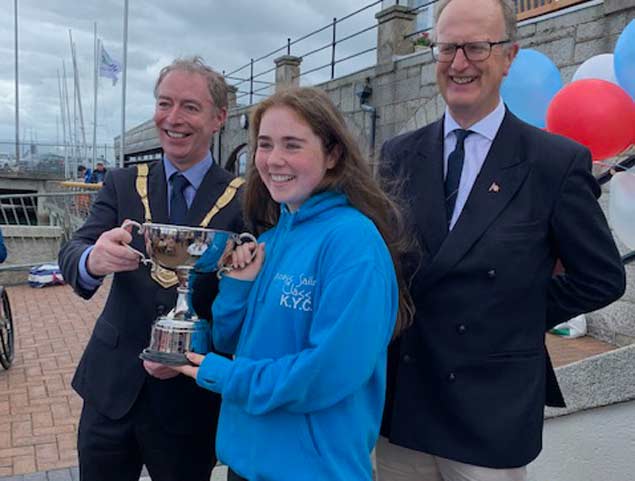 Cara O'Sullivan, Munster, winner of the Hansa Nationals
Cara O'Sullivan, Munster, winner of the Hansa Nationals
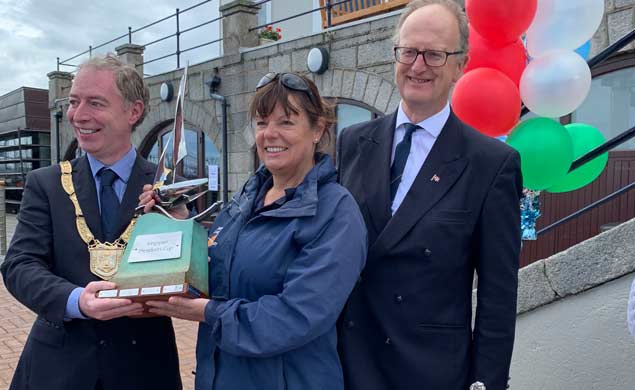 Anne Blair Chairman of Belfast lough Sailability collecting the trophy for Team Ulster
Anne Blair Chairman of Belfast lough Sailability collecting the trophy for Team Ulster
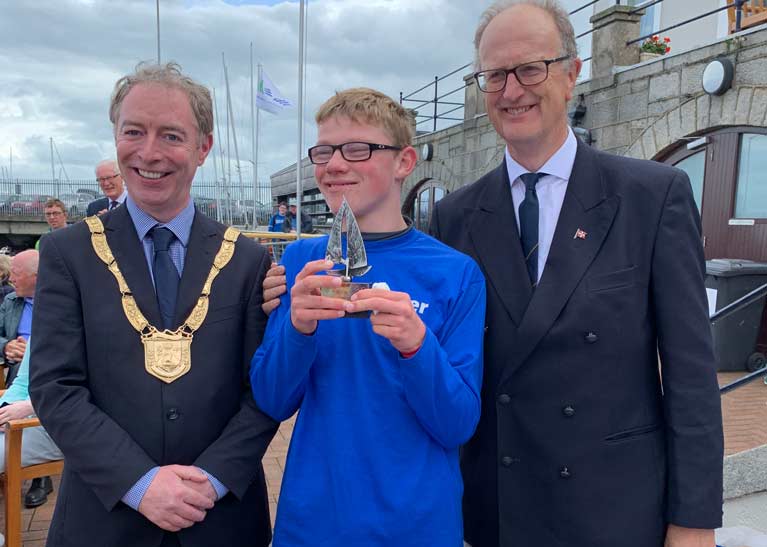 Cian Nolan, Leinster wins Best Newcomer
Cian Nolan, Leinster wins Best Newcomer 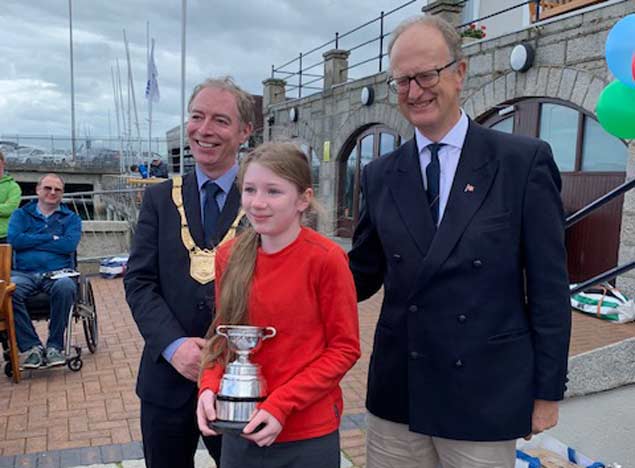 Lucy Kinner, Ulster, best performing youngest junior in Hansa
Lucy Kinner, Ulster, best performing youngest junior in Hansa
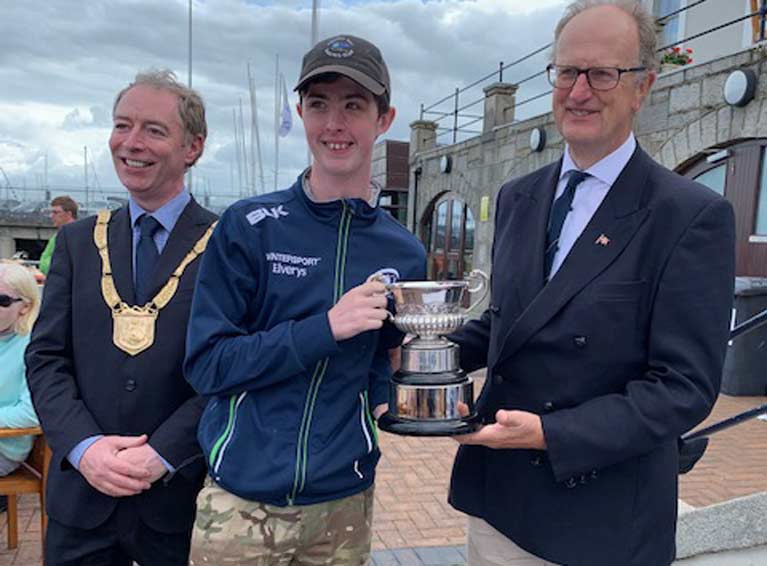 Jack Cunningham, Connaught, wins Best Junior boy
Jack Cunningham, Connaught, wins Best Junior boy
This weekend the Royal St George Yacht Club at Dun Laoghaire Harbour is hosting the President’s Cup and Hansa National Championships.
Inaugurated by Paralympian John Twomey this Irish interprovincial regatta is the highlight of the Sailability calendar. Promoted by Sailability Ireland, this competition is to provide anyone with a disability from the 32 counties of Ireland the opportunity to compete on the water and experience the joys of sailing.
Despite the challenging conditions, there was no stopping these determined competitors getting out on the water and completing three races in each fleet.
After day one, the Ulster team of two Squibs, a Hansa and a 2.4m are leading. With Munster hot on their tail, it’s all to sail for tomorrow.
Leading the fleet of 18 Hansas is Emile Moisy (Munster) with two wins. Cara O‘Sullivan (Munster) and Lucy Kinner (Ulster) in close pursuit. Kevin Downing’s Munster crew lead the eight-boat Squib fleet just ahead of Miriam Quinn’s crew (Leinster) and David Johnstone’s crew (Connaught). John Patrick (Ulster) achieved three wins in the highly competitive 2.4 fleet.
A big thanks to all the volunteers, in particular, the team of buddy sailors, rib drivers, race officers and all those who have provided a helping hand behind the scenes.
Who Says You Can’t Enjoy Sailing? — RYA Supports Charity Campaign To Challenge Perceptions Of Disability In Sport
The RYA is welcoming the launch of a UK-wide disability inclusion campaign and highlighting the benefits of sailing for all participants.
The Activity Alliance’s Who Says? campaign is calling time on negative perceptions about disability, inclusion and sport.
It was created in response to the national charity’s recent research, which explored people’s attitudes on inclusive activity and found that a lack of understanding could be creating long-lasting barriers for people with disabilities.
The findings of the research showed a general lack of awareness, inexperience and unfamiliarity with disabled people although there was a good awareness that sport should be for everyone.
Non-disabled respondents also recognised that they could benefit from taking part in inclusive activities.
However, non-disabled people were concerned about the negative impact taking part together may have on the wellbeing of disabled people.
The top three concerns were that they may patronise disabled people (53%), disabled people may get hurt (47%) or that they may say something inappropriate (37%).
The aim of Who Says? is to empower people to challenge their own and other people’s perceptions through a series of short films.
RYA safeguarding and equality manager Jackie Reid said: “The research shows that certain perceptions around disability in sport should be challenged and it is time for an awareness raising initiative like the Who Says campaign.
“At the RYA we operate on the basis that sailing and boating are open to anyone, no matter what their age or disability and our aim is to facilitate the inclusion of all sailors, whether they want to compete or just have fun on the water.”
The RYA says all of its clubs and training centres should be able to respond appropriately to an enquiry from someone with a disability, and discuss whether they are able to make reasonable adjustments to meet that individual’s needs.
Sailability is the RYA’s national programme in the UK giving people with disabilities the chance to try sailing and to take part regularly.
The British network of more than 200 RYA-approved sailability sites have boats and facilities to cater for people across the whole spectrum of abilities.
RYA sailability manager Joff McGill said: “Challenging perceptions can make a real difference to whether people can get out on the water or not.
“With over 200 locations across the UK, it is easy to get on the water near you and staff and volunteers across the sailability programme are committed to open and positive conversations about what it takes to get each person sailing.
“There are so many benefits – being active, improving wellbeing, new social connections and learning new skills.”
To find out more about sailing opportunities for disabled people, or those that need specific support to get on the water, visit the RYA’s sailability programme web page.




























